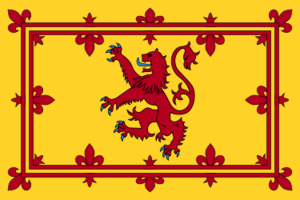Style of the Scottish sovereign facts for kids

The style of the Scottish sovereign is all about the special titles and ways people addressed the kings and queens of Scotland. This includes rulers from the very first ones, like the Picts, all the way to the British monarchs of today. It shows how their titles changed over many centuries.
Contents
Early Royal Titles in Scotland
For a long time, how Scottish rulers were called changed a lot. We learn about these early titles mostly from old Irish writings, like the Annals of Ulster. These records often listed the king's name, then his father's name, and finally his title.
Before the 900s, kings in the area we now call Scotland were often called "King of the Picts" or "King of Fortriu". After the year 900, the title "King of Alba" became more common. Alba was an early name for Scotland. Sometimes, even rulers of other areas, like Moray, were called "kings of Alba" in these old writings.
Titles from the Pictish Period
The Picts were an ancient people who lived in what is now eastern and northern Scotland. Their kings had various titles. For example, some were called:
- Domangurt mac Nissi ri Alban (King of Alba)
- Bruidhe mac Maelchon, ri Cruithneach (King of the Picts)
- Cinaedh m. Ailpin rex Pictorum (Kenneth, son of Alpin, King of the Picts)
These titles show how the names for the rulers and their lands were still developing.
Titles from the Scottish Period
As Scotland became more unified, the titles started to become more consistent. After the 900s, "King of Alba" became the main title. Here are some examples:
- Domnall m. Caustantin, ri Alban (Donald, son of Constantine, King of Alba)
- Mael Coluim m. Cinaedha, ri Alban (Malcolm, son of Kenneth, King of Alba)
- Donnchad m. Crinan, rí Alban (Duncan, son of Crinan, King of Alba)
Sometimes, a king might be called ard-rí Alban, which means "High King of Alba." This showed they were a very important ruler.
Royal Titles in Medieval Charters
A charter was a very important written document, like a formal agreement or a grant of land. In the medieval period, these documents also showed how kings were styled.
One very old example from around the 500s mentions:
- Latin: Nectonius magnus filius Uuirp rex omnium prouiciarum Pictorum
- English: 'Great Nechtan, son of Uurp, King of all the provinces of the Picts'
Later, in the Scottish period, the titles in charters became more standard. Here are some examples:
- Machbet filius Finlach et Gruoch filia Bodhe, rex et regina Scottorum
- English: 'Macbeth son of Findláech and Gruoch daughter of Bodhe, King and Queen of the Scots'. This shows a king and queen together.
- Malcolmus Dei gratia Scottorum basileus
- English: 'Malcolm by the Grace of God, High King of the Scots'. The phrase "by the Grace of God" became very common, showing that kings believed their power came from God.
- Edgarus Dei gratia Rex Scottorum
- English: 'Edgar by the Grace of God, King of the Scots'.
- David Dei gratia Rex Scotiae
- English: 'David by the Grace of God, King of Scotland'.
From King David I onwards, the royal title was usually either "King of the Scots" (rex Scottorum) or "King of Scotland" (rex Scotiae). These two titles were often used interchangeably.
From Late Middle Ages to Union
In the later Middle Ages, "King of the Scots" and "King of Scotland" were still used. For example, Edward II of England was called "king of the English" in the Declaration of Arbroath (1320), a famous letter from Scottish nobles.
However, "King of Scotland" became the more common style in many important documents. This included treaties like the Treaty of Corbeuil (1326) and the Treaty of Edinburgh–Northampton (1328). This continued until the last three monarchs of Scotland: William II, Mary II, and Queen Anne. After the Acts of Union 1707, Scotland joined with England to form the Kingdom of Great Britain, and the titles changed again.
How to Address a Monarch
Your Grace
Before the Acts of Union 1707 in 1707, Scottish monarchs were usually addressed as "Your Grace." This was a respectful way to speak to them.
After 1707, when Scotland became part of the Kingdom of Great Britain, the way to address the monarch changed. From then on, British monarchs were addressed as "Your Majesty," which is still used today.

